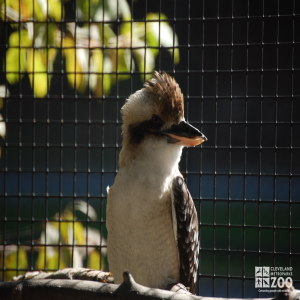Kookaburra
[Dacelo novaeguineae]

The giant kingfisher, or laughing kookaburra, is actually the world's largest kingfisher, though it has taken to dry land and forests, forsaking a fish diet.
Their size and weight are 16 to 18 inches and 3/4 pound. The bill is 2.5 inches. Their wings are small for the bird's body size and flights of a few hundred feet are usually its limit. Its legs are short as are those of all kingfishers. Vision and hearing are very keen. The very heavy, wedge-shaped bill facilitates snake and lizard hunting.
Location: Kookaburra Station
Share:
Range
The range of the laughing kookaburra is Australia.
Habitat
Laughing kookaburras inhabit open forests, arid areas, parks, and gardens.
Conservation Status
Least ConcernPrimary Threats
Gestation
Incubation: 19 to 20 days.
Litter
Clutch: 6-7 eggs
Behavior
Of course it is their laugh that makes the laughing kookaburra so remarkable. It can be rendered as follows: hoo hoo hoo Hoo- Haa Haa Haa Haa Haa Haa- Huh huh huh. So eerie is this sound, bearing implications of crawling creatures and dripping rainforest, that Hollywood producers have put the call in jungle scenes all the way from Brazil to Borneo. The name "Kookaburra," as may be surmised, is an onomatopoeic Aboriginal name. Australian Aborigines say that when a sun rose for the first time on earth, the god Bayame ordered kookaburra to utter its loud laughter to wake up mankind so man should not miss the wonderful sunrise. They live in communal clans which proclaim domination over an area by singing at dusk and dawn. In order to feed, the young bird holds on to one end of the prey while the adult pulls backward at the other end until the body of the victim snaps and is torn apart.
Reproduction
Another interesting feature about the laughing kookaburra concerns incubation of the eggs. Not only do both parents participate, but the whole family - brothers and sisters as well. The appetite of the chicks is remarkable. One captive baby kookaburra was observed to consume, within 6 weeks, 992 grasshoppers, 65 small lizards, 29 moths, and an assortment of dragonflies, crickets, and food scraps.
Wild Diet
Snakes, lizards, insects, crabs, eggs, nestlings.
Zoo Diet
Insectivorous diet, strips of heart, liver, fish.
